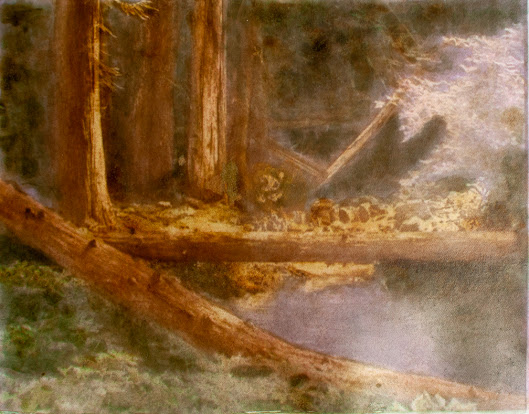I have narrowed the pace of printing, beginning with this print, from four prints at a time, down to just the one print I'm working on. No need to say that this arrangement is so much easier on my constitution, and I believe to the detriment of printing itself. Divided attention while juggling four multi-layered prints, I am learning, dilutes the focus and attention to detail and planning as focusing on a single print with its set of defined needs, to arrive at the print image desired.
This image originated as a black and white negative; exposed in a Burke & James 5x7 view camera; circa 1984. In the early 2000's, during the last ten years of working with digital imagery, I digitally hand colored this image, and the one to come next. I liked what I saw, in spite of my having been a black & white printer. It was very recently, during a perusal of some old images worthy of gum printing, and came across the images, realizing gum colors would work quite well with the image. The task would be containing the light in the scene, holding the print values to show what the light was doing, and the effect of the light on the setting in front of me when I captured the image.
One of the things I may not get right are the digital copy of the print, trying to make the digital image, the fidelity of the colors. Being red/green color blind doesn't help me in that endeavor. I believe I am very close to the lighting and colors of the print. I am using north light when digitally photographing the print.
This print consists of fifteen color print layers, using twenty color mixtures. It is printed on Fabriano Artistico rag paper. sized with two soaks in 2.85% gelatin at 110 degrees F. It is with this print that I began working with various densities of the gum mixture; into 50%, 75% and 100% gum mixes. Yes, very thick, at 100% like raw honey at room temperature. But, it allows for local applications, using dobbing brush techniques to enhance an area, or even create a sort of textural effect to the image. Such is a 'green bush' center background of the image.
Most of the fuller layers, as well as much of the local applications to the flora in sunlight, the trees, and the branches of the trees in the background were of the 75% gum mixture applications. The proceeding image will have more layers of 50% gum mixtures, as historically done in the past, as I added a final soak of 4% gelatin in 110 degree water on top of the two soaks at 2.85%, as historically done. I am happy with the final results.
Gum Dichromate Print ~ Unique
"Proxy Falls" 11"x14"
Proxy Falls, Oregon ~ Circa 1984






























